Perspective on unstructured grid flow solvers
黏塑性流体运动的二维浅水方程模拟
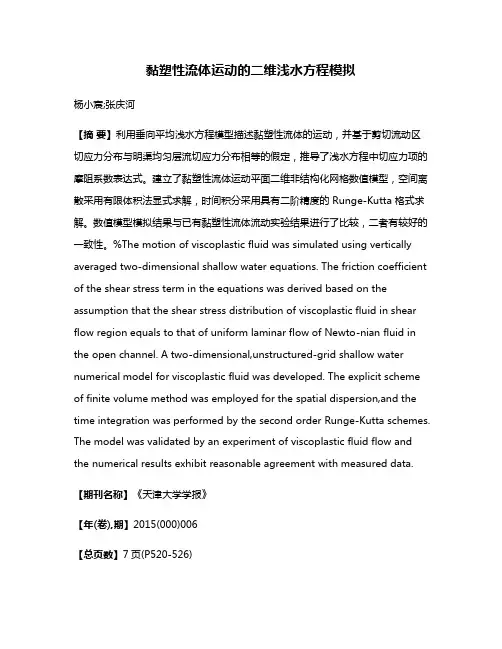
黏塑性流体运动的二维浅水方程模拟杨小宸;张庆河【摘要】利用垂向平均浅水方程模型描述黏塑性流体的运动,并基于剪切流动区切应力分布与明渠均匀层流切应力分布相等的假定,推导了浅水方程中切应力项的摩阻系数表达式。
建立了黏塑性流体运动平面二维非结构化网格数值模型,空间离散采用有限体积法显式求解,时间积分采用具有二阶精度的 Runge-Kutta 格式求解。
数值模型模拟结果与已有黏塑性流体流动实验结果进行了比较,二者有较好的一致性。
%The motion of viscoplastic fluid was simulated using vertically averaged two-dimensional shallow water equations. The friction coefficient of the shear stress term in the equations was derived based on the assumption that the shear stress distribution of viscoplastic fluid in shear flow region equals to that of uniform laminar flow of Newto-nian fluid in the open channel. A two-dimensional,unstructured-grid shallow water numerical model for viscoplastic fluid was developed. The explicit scheme of finite volume method was employed for the spatial dispersion,and the time integration was performed by the second order Runge-Kutta schemes. The model was validated by an experiment of viscoplastic fluid flow and the numerical results exhibit reasonable agreement with measured data.【期刊名称】《天津大学学报》【年(卷),期】2015(000)006【总页数】7页(P520-526)【关键词】黏塑性流体;二维浅水方程;摩阻系数;有限体积法;非结构化网格【作者】杨小宸;张庆河【作者单位】天津大学水利工程仿真与安全国家重点实验室,天津 300072;天津大学水利工程仿真与安全国家重点实验室,天津 300072【正文语种】中文【中图分类】TV148.1淤泥质河口海岸地区,常常会在近底部形成一层具有流动性的高浓度含沙水体,当其浓度达到一定程度时就会形成浮泥.浮泥的存在对于港口航道淤积、河口海岸环境和港口管理等方面都有重要影响.因此,通过数值模拟描述浮泥的流动对于预测航道淤积和港口航道整治具有重要的意义.合理描述浮泥流动需要建立水体-浮泥双层运动模型,而其中的关键之处是如何描述底部浮泥的流动过程.由于浮泥往往可以看作黏塑性流体[1],因此,建立黏塑性流体运动模型来模拟近底部浮泥的运动具有实际意义.目前对于黏塑性流体的模拟包括求解N-S方程[2-8]、求解浅水方程[1,9-13]及其他方法[14].从浮泥运动的空间尺度看,由于浮泥主要集中于床面附近,其平面尺度远大于垂向尺度,因此,采用浅水方程求解浮泥运动是一种比较合理的方法.采用浅水方程来描述黏塑性流体运动,需要通过方程中的摩阻项来体现黏塑性流体复杂流变特性的影响.Laigle和Coussot[1]、Martinez[12]通过相对剪切率和流变参数求解摩阻项.Odd和Cooper[9]、Winterwerp等[10]、Wang等[11]和Canestrelli 等[13]都是通过引入摩阻系数表示摩阻项,但其中摩阻系数的取值则往往由经验确定.因此,在采用二维浅水方程求解黏塑性流体运动的数值模型中,如何合理地确定摩阻系数仍是目前有待解决的问题.为此,本文将在一定的假定条件下,依据黏塑性流体的流变方程,推导二维浅水方程中黏塑性流体层流运动的摩阻系数,以避免摩阻系数确定的经验性.在此基础上利用有限体积法,建立黏塑性流体运动平面二维数值模型,并进一步采用已有黏塑性流体流动实验数据对建立的模型进行验证.1.1 控制方程黏塑性流体平面二维浅水方程模型的控制方程为质量守恒方程和动量方程,即式中:um和vm分别为x和y方向流体的垂向平均流速;f为科氏力系数;g为重力加速度;hm为流体表面高程,hm=Z+ h ,其中Z为底床高程,h为流体厚度;rm为流体密度;t0,x和t0,y分别为x和y方向的底部摩阻应力,其表达式为式中fm为摩阻系数.如何合理地确定黏塑性流体的摩阻系数fm成为求解上述模型的关键.1.2 边界条件黏塑性流体二维浅水方程模型的边界条件包括开边界条件、闭边界条件和动边界条件.开边界处可设定一定的流体厚度及施加一定的流量.岸线或建筑物边界可视为闭边界,流体可沿切向自由滑移,则闭边界的边界条件可表示为式中:um为流体的速度矢量;n为固壁边界的外法线方向.对于动边界的处理,采用干湿网格处理技术,干湿网格判断标准定义为:对于节点,h>0为湿节点,h≤0为干节点;对于三角形单元,max(hi, hj, hk )> 0为湿单元,max(hi, hj, hk)≤0为干单元,其中i、j和k分别为三角形单元的3个节点的编号.1.3 黏塑性流体摩阻系数的推导已有研究表明,具有屈服应力的黏塑性流体在明渠中流动时,其流速分布在垂向存在整体向前均匀流动、没有相对剪切率的“流核区”,即在切应力等于屈服应力的屈服表面以上,为非剪切流核区,而屈服表面以下则为剪切流动区[15-16].为了推导黏塑性流体摩阻系数与平均流速的关系,这里近似假定剪切流动区切应力分布与明渠均匀层流切应力分布相等.Herschel-Bulkley型黏塑性流体的流变方程为式中:t为切应力;tB为屈服应力;K为黏度系数;n为流动指数;u为流体在各高度z处的速度;¶um,zm,z¶z代表剪切率.明渠均匀层流切应力分布为式中J为水力坡度.则位于底部摩阻应力t0及位于屈服表面的屈服应力tB分别为式中hB为屈服表面的高度,即切应力等于屈服应力的高度.根据剪切流动区切应力分布相等的假设,可推求剪切流动区流速沿垂向的分布为在流核区,流动速度不随垂向高度变化,均为z=hB时的流速,即将流核区和剪切流动区的流速沿垂向积分,即得到沿垂向的平均流速um的表达式为令Ne =t B/t0 =(h - h B )/η ,则引入摩阻系数fm与底部摩阻应力0t的关系,又由式(8)可得则可建立水力坡度与摩阻系数的关系为将式(15)代入式(13),可建立摩阻系数与平均流速的关系为根据,可得到因此,当已知流变参数和平均流速时,通过式(16)和式(17)迭代求解,即可获得黏塑性流体的摩阻系数.以上推导是以Herschel-Bulkley流变模型为例进行的,当黏度系数K取为宾汉体黏性系数h、n1=时,为宾汉流体,代入式(16)可获得宾汉体摩阻系数计算式式中ReB为宾汉雷诺数,R eB =(r mumh )/η.式(18)与张道成[17]的宾汉体摩阻系数结果相同.进一步,当屈服应力tB=0、K取为水的黏性系数m、n=1时,该流体变为牛顿流体.由于tB=0,则Ne =tB/t0 =0,代入式(16)得到牛顿流体摩阻系数式中Re为雷诺数,R e =(ρmumh )/μ.式(19)与文献[18]中的明渠水流层流摩阻系数公式吻合.平面二维黏塑性体运动数值模型基于非结构化网格建立,空间离散采用有限体积法显式求解,时间积分采用Runge-Kutta格式求解.计算区域划分为若干无重合的三角形单元,如图1所示,每个三角形单元由3个节点(·)、3条边和一个单元中心(Å)组成.流体厚度h和表面高程mh等变量定义在节点上,流体流速um和vm等变量定义在单元中心上.将计算区域划分为N个三角形单元,三角形中心和节点的总个数分别为N和M,则各三角形中心坐标为[X C(i) , Y C (i) ] ( i=1 , 2,L ,N );三角形节点坐标为[X (j) , Y (j) ] ( j=1 , 2,L ,M);三角形各边中点坐标分别为Xs 和Ys.对于任一三角形中心i,围绕该三角形的3个节点以整数来表示,与其共用一条边的单元记为NBEi(ˆ),ˆ以顺时针由1排到3.对于任一节点j,与该节点相邻的三角形单元个数记为NT(j ),并以整数NBi(m )标号,其中m以顺时针由1排到NT(j ).定义与某一节点相连的单元中心和边中点的连线构成示踪控制体,节点上的变量由通过该控制体的净通量计算;定义由构成每个三角形单元的三边连接构成动量控制体,单元中心的变量由通过该控制体三边的净通量进行计算.首先对浮泥模型的质量平衡方程离散求解,在给定的三角形区域内积分,式(1)可写为式中:vms为浮泥流速垂直于边的分量;s¢为由三角形单元的三条边所组成的闭合轨迹,并记¢为通量Rd.对式(20)采用具有二阶精度的Runge-Kutta时间积分求解,即式中:上标T代表第T个时间步;k =1 ,2,3,4,对应的ak=1 /4,1/3,1/2,1;hj为节点j处的流体厚度;代表节点j所在的示踪控制体构成的区域面积;Dt为计算时间步长;hT为围绕节点j的各单元中心处的流体厚度值,由该单元3个节点插值获得;分别为单元中心处流体的流速值;x和y分别为下面对动量方程(2)和(3)离散求解,在给定的三角形区域内积分,得到将等式右侧各通量合并记为Ru和Rv,式(24)和式(25)可简写为同样采用Runge-Kutta时间积分求解,得到式中:和为um和vm所在三角形单元的面积,由于本模型的um和vm位于同一中心,因此为三角形单元中心处的流体厚度;Ru和Rv分别表示为式中,XADV和YADV,PSTXM和PSTYM,CORX 和CORY,TAUX和TAUY 分别为与式(24)和式(25)对应的对流项、流体表面压力梯度项、科氏力项和切应力项在x和y方向的分量.下面分别介绍各项的计算过程.对流项在x和y方向的分量分别表示为式中:um,i , s和vm,i , s分别为三角形单元边s中点处流体流速在x和y方向的分量;vms, s为垂直于该边的流体流速值,方向向外为正向;hs为该边中点处流体厚度值;为该边的长度.流体表面压力梯度项在x和y方向的分量分别表示为式中:Z为三角形单元边s中点处的底部高程;sN i(j1)和Ni(j2)分别为边s的两端点的节点号.科氏力项在x和y方向的分量分别表示为切应力项在x和y方向的分量分别表示为式中t和t为流体摩阻切应力在三角形单元i中0,x , i0,y , i心处的值,由式(4)计算得到.采用Cochard和Ancey[19]的黏塑性流体流动实验验证第2节建立的平面二维黏塑性流体运动模型.实验在可调节坡度的底坡上进行,底坡长5.5,m,宽1.8,m,顶端有长51,cm、宽30,cm的贮存池,对由不同浓度的卡波树脂U10(一种聚丙烯酸聚合物,具有增稠和流变改性作用)、NaOH和水组成的黏塑性流体进行了溃坝流动实验,采用CCD照相机测量流体自由表面的变化过程.实验所用的黏塑性流体的流变特性采用Herschel-Bulkley模型描述,并通过流变实验确定了参数.本文选取卡波树脂U10质量分数为30%、底坡坡度为6°的一组实验进行模拟,流体密度为811,kg/m3,实验布置[19]如图2所示.数值模拟计算区域长5.5,m,宽1.8,m,采用非结构化网格,最小网格尺度为0.05,m,计算时间步长为0.002,s.计算区域左右两侧设置为开边界,左侧入口边界根据实测数据设定不同时刻流体的高度并根据流入体积施加一定的流量,右侧为出流边界.流变实验确定的流变参数为tc=8 9 Pa ,K =4 7.68 Pa/sn,n=0 .415,代入式(16)计算各时刻的底部摩阻系数,并应用本文建立的黏塑性流体运动模型模拟实验流体的运动.模拟得到的实验流体在各个时刻的流动厚度和流动边缘与实测数据的对比见图3和图4.模拟结果与实测结果较为接近,但由于本文的数值算法暂未模拟实际的溃坝间断问题,因此通过在左侧入口开边界施加不同时刻的流体高度以及根据实验时不同时刻的流入体积估算出的流量来设定入口边界,这与实验入口初速度不一定完全相同;另外,在实际流动中流体的表面张力可能也起到一定的作用,本文的模型中暂未考虑,因此计算结果与实测结果仍有一定的差异.模拟中由式(16)计算得到的底部摩阻系数的值是随着实验流体的流动状态而变化的,本次计算中fm的值介于5~80之间.为了体现出本文所提出的底部摩阻系数确定方法的合理性,将本文的计算结果与fm取为定值(分别为fm=5、fm=60和fm=80)的情况进行对比.不同摩阻系数取值情况时实验流体前端位置及流动宽度与实测数据的对比分别见图5和图6.由图5可见,对于摩阻系数较小的fm=5情况,流体在2,s前基本能够符合实际流动结果,但之后流动较快,甚至在200,s时已达到计算域末端,与实测结果有较大差异.对于摩阻系数较大的fm=80情况,流动前沿位置始终小于实测结果;而摩阻系数fm=60的情况下,虽然在200,s时流动前沿位置基本与实测结果相符,但前期流动与实测结果相比仍较慢,只有摩阻系数由式(16)计算的情况下才能够较准确地描述出流体前端的位置.图6中流体宽度对比结果显示,除fm5=情况下流体宽度过大外,其他几种情况下流体宽度与实测结果均比较接近,可见摩阻系数对沿斜坡长度方向的流动的影响更明显.以上结果表明,本文的摩阻系数推求方法与摩阻系数经验性地取为定值相比,能更合理地描述黏塑性流体运动,同时模拟结果与实验结果的对比表明本文所建模型能够较合理地描述黏塑性流体的运动过程.本文提出了一种黏塑性流体摩阻系数近似推求方法,并将其引入黏塑性流体的浅水方程中,建立了黏塑性流体平面二维运动模型.模型的求解基于非结构化网格,采用有限体积法进行数值离散.数值模型模拟与黏塑性流体流动实验结果比较表明,模拟结果与实测结果总体较为吻合,只是由于入口边界和表面张力等的影响在模型中尚未能充分合理考虑,二者相比还有一些差异.本文提出的摩阻系数近似推求方法与摩阻系数经验性地取为定值相比,模拟结果更接近实测结果,能够更合理地描述黏塑性流体的运动.此外,需要指出的是,由于推导黏塑性流体摩阻系数时假设切应力与均匀层流切应力相符,本文模型一般仅适用于底坡较缓、黏塑性流体处于层流流动状态的问题.但总体来看,本文所提出的黏塑性流体摩阻系数推求方法避免了摩阻系数取值的经验性,可以进一步应用于河口海岸浮泥流动问题的研究中.为了进一步扩大模型应用范围,在以后的研究中将针对紊流情况进行改进,并与水流模型结合建立水流-浮泥双层模型,以期合理地描述河口海岸地区的浮泥运动.【相关文献】[1] Laigle D,Coussot P. Numerical modeling of mudflows[J]. Journal of Hydraulic Engineering,1997,123(7):617-623.[2] Yan Y. Laterally-Averaged Numerical Modeling of Fluid Mud Formation and Movement in Estuaries[D]. Clemson:Department of Civil Engineering,Clemson University,1995.[3] Le Hir P,Bassoullet P,Jestin H. Application of the continuous modeling concept to simulate highconcentration suspended sediment in a macrotidal estuary[J]. Proceedingsin Marine Science,2000,3:229-247.[4] Watanabe R,Kusuda T,Yamanishi H,et al. Modeling of fluid mud flow on an inclined bed[J]. Proceedings in Marine Science,2000,3:249-261.[5] Guan W B,Kot S C,Wolanski E. 3-D fluid-mud dynamics in the Jiaojiang Estuary,China[J]. Estuarine,Coastal and Shelf Science,2005,65(4):747-762.[6]马宗源,廖红建,张骏. Bingham型黏性泥石流流体的三维数值模拟[J]. 西安交通大学学报,2008,42(9):1146-1150. Ma Zongyuan,Liao Hongjian,Zhang Jun. Three dimensional numerical simulation of Bingham viscous debris flow fluid[J]. Journal of Xi’an Jiaotong University,2008,42(9):1146-1150(in Chinese).[7] Knoch D,Malcherec A. A numerical model for simulation of fluid mud with different rheological behaviors[J]. Ocean Dynamics,2011,61(2):245-256.[8] Minatti L,Pasculli A. SPH numerical approach in modeling 2D muddy debrisflow[C]//Italian Journal of Engineering Geology and Environment,5th International Conference on Debris-Flow Hazards Mitigation,Mechanics,Prediction and Assessment. Padua,Italy,2011:467-475.[9] Odd N M V,Cooper A J. A two-dimensional model of the movement of fluid mudin a high energy turbid estuary[J]. Journal of Coastal Research,1989(SI5):185-193. [10] Winterwerp J C,Wang Z B,van Kester J A Th M,et al. Far-field impact of water injection dredging in the Crouch River[J]. Proceedings of the ICE-Water and Maritime Engineering,2002,154(4):285-296.[11] Wang L,Winter C,Schrottke K,et al. Modelling of estuarine fluid mud evolution in troughs of large subaqueous dune[C]//Proceedings of the Chinese-German Joint Symposium on Hydraulic and Ocean Engineering. Darmstadt,Germany,2008:372-379. [12] Martinez C E. Eulerian-Lagrangian Two Phase Debris Flow Model[D]. Miami:College of Engineering and Computing,Florida International University,2009.[13] Canestrelli A,Fagherazzi S,Lanzoni S. A massconservative centered finite volume model for solving two-dimensional two-layer shallow water equations for fluid mud propagation over varying topography and dry areas[J]. Advances in Water Resources,2012,40:54-70.[14] Hsu T J,Ozdemir C E,Traykovski P A. Highresolution numerical modeling of wave-supported gravity-driven mudflows[J]. Journal of Geophysical Research,2009,114(C05014):1-15.[15] Mei C C,Yuhi M. Slow flow of a Bingham fluid in a shallow channel of finite width[J]. Journal of Fluid Mechanics,2001,431:135-159.[16] Yuhi M,Mei C C. Slow spreading of fluid mud over a conical surface[J]. Journal of Fluid Mechanics,2004,519:337-358.[17]张道成. 宾汉流体在明渠均匀层流中的流变参数和阻力规律研究[J]. 成都科技大学学报,1990(1):89-96. Zhang Daocheng. Preliminary study on the rheological parameters of Bingham fluid in laminar and uniform open channel flow[J]. Journal of Chengdu University of Science and Technology,1990(1):89-96(in Chinese).[18]李佳星,赵振兴. 水力学[M]. 南京:河海大学出版社,2001. Li Jiaxing,Zhao Zhenxing. Hydraulics[M]. Nanjing:Hohai University Press,2001(in Chinese).[19] Cochard S,Ancey C. Experimental investigation of the spreading of viscoplastic fluids on inclined planes[J]. Journal of Non-Newtonian Fluid Mechanics,2009,158(1/2/3):73-84.。
顾及图像增强的煤矿井下视觉同时定位与建图算法
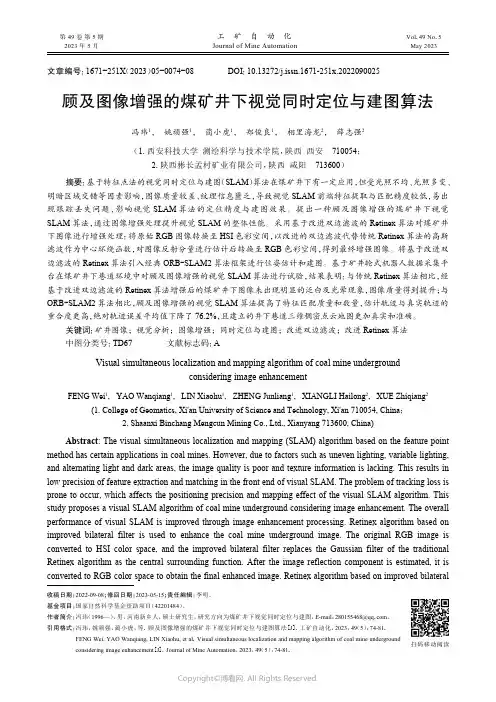
顾及图像增强的煤矿井下视觉同时定位与建图算法冯玮1, 姚顽强1, 蔺小虎1, 郑俊良1, 相里海龙2, 薛志强2(1. 西安科技大学 测绘科学与技术学院,陕西 西安 710054;2. 陕西彬长孟村矿业有限公司,陕西 咸阳 713600)摘要:基于特征点法的视觉同时定位与建图(SLAM )算法在煤矿井下有一定应用,但受光照不均、光照多变、明暗区域交错等因素影响,图像质量较差、纹理信息匮乏,导致视觉SLAM 前端特征提取与匹配精度较低,易出现跟踪丢失问题,影响视觉SLAM 算法的定位精度与建图效果。
提出一种顾及图像增强的煤矿井下视觉SLAM 算法,通过图像增强处理提升视觉SLAM 的整体性能。
采用基于改进双边滤波的Retinex 算法对煤矿井下图像进行增强处理:将原始RGB 图像转换至HSI 色彩空间,以改进的双边滤波代替传统Retinex 算法的高斯滤波作为中心环绕函数,对图像反射分量进行估计后转换至RGB 色彩空间,得到最终增强图像。
将基于改进双边滤波的Retinex 算法引入经典ORB −SLAM2算法框架进行位姿估计和建图。
基于矿井轮式机器人数据采集平台在煤矿井下巷道环境中对顾及图像增强的视觉SLAM 算法进行试验,结果表明:与传统Retinex 算法相比,经基于改进双边滤波的Retinex 算法增强后的煤矿井下图像未出现明显的泛白及光晕现象,图像质量得到提升;与ORB −SLAM2算法相比,顾及图像增强的视觉SLAM 算法提高了特征匹配质量和数量,估计轨迹与真实轨迹的重合度更高,绝对轨迹误差平均值下降了76.2%,且建立的井下巷道三维稠密点云地图更加真实和准确。
关键词:矿井图像;视觉分析;图像增强;同时定位与建图;改进双边滤波;改进Retinex 算法中图分类号:TD67 文献标志码:AVisual simultaneous localization and mapping algorithm of coal mine undergroundconsidering image enhancementFENG Wei 1, YAO Wanqiang 1, LIN Xiaohu 1, ZHENG Junliang 1, XIANGLI Hailong 2, XUE Zhiqiang 2(1. College of Geomatics, Xi'an University of Science and Technology, Xi'an 710054, China ;2. Shaanxi Binchang Mengcun Mining Co., Ltd., Xianyang 713600, China)Abstract : The visual simultaneous localization and mapping (SLAM) algorithm based on the feature point method has certain applications in coal mines. However, due to factors such as uneven lighting, variable lighting,and alternating light and dark areas, the image quality is poor and texture information is lacking. This results in low precision of feature extraction and matching in the front end of visual SLAM. The problem of tracking loss is prone to occur, which affects the positioning precision and mapping effect of the visual SLAM algorithm. This study proposes a visual SLAM algorithm of coal mine underground considering image enhancement. The overall performance of visual SLAM is improved through image enhancement processing. Retinex algorithm based on improved bilateral filter is used to enhance the coal mine underground image. The original RGB image is converted to HSI color space, and the improved bilateral filter replaces the Gaussian filter of the traditional Retinex algorithm as the central surrounding function. After the image reflection component is estimated, it is converted to RGB color space to obtain the final enhanced image. Retinex algorithm based on improved bilateral收稿日期:2022-09-08;修回日期:2023-05-15;责任编辑:李明。
空间目标轨道外热流计算及辐射特性研究
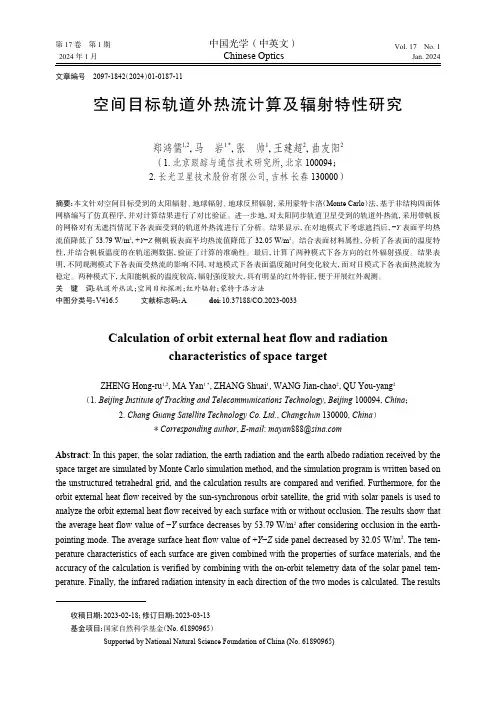
文章编号 2097-1842(2024)01-0187-11空间目标轨道外热流计算及辐射特性研究郑鸿儒1,2,马 岩1 *,张 帅1,王建超2,曲友阳2(1. 北京跟踪与通信技术研究所, 北京 100094;2. 长光卫星技术股份有限公司, 吉林 长春 130000)摘要:本文针对空间目标受到的太阳辐射、地球辐射、地球反照辐射,采用蒙特卡洛(Monte Carlo )法,基于非结构四面体网格编写了仿真程序,并对计算结果进行了对比验证。
进一步地,对太阳同步轨道卫星受到的轨道外热流,采用带帆板的网格对有无遮挡情况下各表面受到的轨道外热流进行了分析。
结果显示,在对地模式下考虑遮挡后,−Y 表面平均热流值降低了53.79 W/m 2,+Y −Z 侧帆板表面平均热流值降低了32.05 W/m 2。
结合表面材料属性,分析了各表面的温度特性,并结合帆板温度的在轨遥测数据,验证了计算的准确性。
最后,计算了两种模式下各方向的红外辐射强度。
结果表明,不同观测模式下各表面受热流的影响不同,对地模式下各表面温度随时间变化较大,而对日模式下各表面热流较为稳定。
两种模式下,太阳能帆板的温度较高,辐射强度较大,具有明显的红外特征,便于开展红外观测。
关 键 词:轨道外热流;空间目标探测;红外辐射;蒙特卡洛方法中图分类号:V416.5 文献标志码:A doi :10.37188/CO.2023-0033Calculation of orbit external heat flow and radiationcharacteristics of space targetZHENG Hong-ru 1,2,MA Yan 1 *,ZHANG Shuai 1,WANG Jian-chao 2,QU You-yang 2(1. Beijing Institute of Tracking and Telecommunications Technology , Beijing 100094, China ;2. Chang Guang Satellite Technology Co. Ltd., Changchun 130000, China )* Corresponding author ,E-mail : mayan 888@Abstract : In this paper, the solar radiation, the earth radiation and the earth albedo radiation received by the space target are simulated by Monte Carlo simulation method, and the simulation program is written based on the unstructured tetrahedral grid, and the calculation results are compared and verified. Furthermore, for the orbit external heat flow received by the sun-synchronous orbit satellite, the grid with solar panels is used to analyze the orbit external heat flow received by each surface with or without occlusion. The results show that the average heat flow value of −Y surface decreases by 53.79 W/m 2 after considering occlusion in the earth-pointing mode. The average surface heat flow value of +Y −Z side panel decreased by 32.05 W/m 2. The tem-perature characteristics of each surface are given combined with the properties of surface materials, and the accuracy of the calculation is verified by combining with the on-orbit telemetry data of the solar panel tem-perature. Finally, the infrared radiation intensity in each direction of the two modes is calculated. The results收稿日期:2023-02-18;修订日期:2023-03-13基金项目:国家自然科学基金(No. 61890965)Supported by National Natural Science Foundation of China (No. 61890965)第 17 卷 第 1 期中国光学(中英文)Vol. 17 No. 12024年1月Chinese OpticsJan. 2024show that the influence of heat flow on the surface is different under different observation modes. The tem-perature of each surface varies greatly over time in the earth-pointing mode, while the heat flow on each sur-face is relatively stable in the sun-pointing mode. Under both modes, the temperature of the solar panel is higher, the radiation intensity is larger, and it has obvious infrared characteristics, which facilitates infrared observation.Key words: orbit external heat flow;space target detection;infrared radiation;Monte Carlo method1 引 言目前各国对空间资源的争夺愈演愈烈,空间态势感知技术对国防的战略意义日益凸显,如何对空间目标进行有效监视成为亟需解决的问题之一。
和工作岗位、企业有关的英语名词
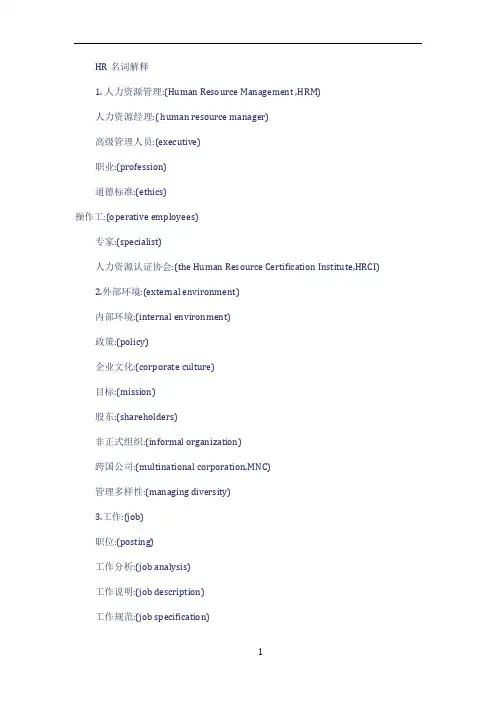
HR名词解释1. 人力资源管理:(Human Resource Management ,HRM)人力资源经理:( human resource manager)高级管理人员:(executive)职业:(profession)道德标准:(ethics)操作工:(operative employees)专家:(specialist)人力资源认证协会:(the Human Resource Certification Institute,HRCI)2.外部环境:(external environment)内部环境:(internal environment)政策:(policy)企业文化:(corporate culture)目标:(mission)股东:(shareholders)非正式组织:(informal organization)跨国公司:(multinational corporation,MNC)管理多样性:(managing diversity)3.工作:(job)职位:(posting)工作分析:(job analysis)工作说明:(job description)工作规范:(job specification)工作分析计划表:(job analysis schedule,JAS)职位分析问卷调查法:(Management Position Description Questionnaire,MPD Q)行政秘书:(executive secretary)地区服务经理助理:(assistant district service manager)4.人力资源计划:(Human Resource Planning,HRP)战略规划:(strategic planning)长期趋势:(long term trend)要求预测:(requirement forecast)供给预测:(availability forecast)管理人力储备:(management inventory)裁减:(downsizing)人力资源信息系统:(Human Resource Information System,HRIS)5.招聘:(recruitment)员工申请表:(employee requisition)招聘方法:(recruitment methods)内部提升:(Promotion From Within ,PFW)工作公告:(job posting)广告:(advertising)职业介绍所:(employment agency)特殊事件:(special events)实习:(internship)6.选择:(selection)选择率:(selection rate)简历:(resume)标准化:(standardization)有效性:(validity)客观性:(objectivity)规范:(norm)录用分数线:(cutoff score)准确度:(aiming)业务知识测试:(job knowledge tests)求职面试:(employment interview)非结构化面试:(unstructured interview)结构化面试:(structured interview)小组面试:(group interview)职业兴趣测试:(vocational interest tests)会议型面试:(board interview)7.组织变化与人力资源开发人力资源开发:(Human Resource Development,HRD) 培训:(training)开发:(development)定位:(orientation)训练:(coaching)辅导:(mentoring)经营管理策略:(business games)案例研究:(case study)会议方法:(conference method)角色扮演:(role playing)工作轮换:(job rotating)在职培训:(on-the-job training ,OJT)媒介:(media)8.企业文化与组织发展企业文化:(corporate culture)组织发展:(organization development,OD)调查反馈:(survey feedback)质量圈:(quality circles)目标管理:(management by objective,MBO)全面质量管理:(Total Quality Management,TQM) 团队建设:(team building)9.职业计划与发展职业:(career)职业计划:(career planning)职业道路:(career path)职业发展:(career development)自我评价:(self-assessment)职业动机:(career anchors)10.绩效评价绩效评价:(Performance Appraisal,PA)小组评价:(group appraisal)业绩评定表:(rating scales method)关键事件法:(critical incident method)排列法:(ranking method)平行比较法:(paired comparison)硬性分布法:(forced distribution method)晕圈错误:(halo error)宽松:(leniency)严格:(strictness)3600反馈:(360-degree feedback)叙述法:(essay method)集中趋势:(central tendency)11.报酬与福利报酬:(compensation)直接经济报酬:(direct financial compensation)间接经济报酬:(indirect financial compensation) 非经济报酬:(no financial compensation)公平:(equity)外部公平:(external equity)内部公平:(internal equity)员工公平:(employee equity)小组公平:(team equity)工资水平领先者:(pay leaders)现行工资率:(going rate)工资水平居后者:(pay followers)劳动力市场:(labor market)工作评价:(job evaluation)排列法:(ranking method)分类法:(classification method)因素比较法:(factor comparison method)评分法:(point method)海氏指示图表个人能力分析法:(Hay Guide Chart-profile Method) 工作定价:(job pricing)工资等级:(pay grade)工资曲线:(wage curve)工资幅度:(pay range)12.福利和其它报酬问题福利(间接经济补偿)员工股权计划:(employee stock ownership plan,ESOP)值班津贴:(shift differential)奖金:(incentive compensation)分红制:(profit sharing)13.安全与健康的工作环境安全:(safety)健康:(health)频率:(frequency rate)紧张:(stress)角色冲突:(role conflict)催眠法:(hypnosis)酗酒:(alcoholism)14.员工和劳动关系工会:(union)地方工会:(local union)行业工会:(craft union)产业工会:(industrial union)全国工会:(national union)谈判组:(bargaining union)劳资谈判:(collective bargaining)仲裁:(arbitration)罢工:(strike)内部员工关系:(internal employee relations) 纪律:(discipline)纪律处分:(disciplinary action)申诉:(grievance)降职:(demotion)调动:(transfer)晋升:(promotion)2. AAction learning:行动学习Alternation ranking method:交替排序法Annual bonus:年终分红Application forms:工作申请表Appraisal interview:评价面试Aptitudes:资质Arbitration:仲裁Attendance incentive plan:参与式激励计划Authority:职权BBehavior modeling:行为模拟Behaviorally anchored rating scale (bars):行为锚定等级评价法Benchmark job:基准职位Benefits:福利Bias:个人偏见Boycott:联合抵制Bumping/layoff procedures:工作替换/临时解雇程序Burnout:耗竭CCandidate-order error:候选人次序错误Capital accumulation program:资本积累方案Career anchors:职业锚Career cycle:职业周期Career planning and development:职业规划与职业发展Case study method:案例研究方法Central tendency:居中趋势Citations:传讯Civil Rights Act:民权法Classes:类Classification (or grading) method:归类(或分级)法Collective bargaining:集体谈判Comparable worth:可比价值Compensable factor:报酬因素Computerized forecast:计算机化预测Content validity:内容效度Criterion validity:效标效度Critical incident method:关键事件法DDavis-Bacon Act (DBA):戴维斯―佩根法案Day-to-day-collective bargaining:日常集体谈判Decline stage:下降阶段Deferred profit-sharing plan:延期利润分享计划Defined benefit:固定福利Defined contribution:固定缴款Department of Labor job analysis:劳工部工作分析法Discipline:纪律Dismissal:解雇;开除Downsizing:精简EEarly retirement window:提前退休窗口Economic strike:经济罢工Edgar Schein:艾德加?施恩Employee compensation:职员报酬Employee orientation:雇员上岗引导Employee Retirement Income Security Act (ERISA) :雇员退休收入保障法案Employee services benefits:雇员服务福利Employee stock ownership plan (ESOP) :雇员持股计划Equal Pay Act:公平工资法Establishment stage:确立阶段Exit interviews:离职面谈Expectancy chart:期望图表Experimentation:实验Exploration stage:探索阶段FFact-finder:调查Fair day's work:公平日工作Fair Labor Standards Act:公平劳动标准法案Flexible benefits programs:弹性福利计划Flex place:弹性工作地点Flextime:弹性工作时间Forced distribution method:强制分布法Four-day workweek:每周4天工作制Frederick Taylor:弗雷德里克?泰罗Functional control:职能控制Functional job analysis:功能性工作分析法GGeneral economic conditions:一般经济状况Golden offerings:高龄给付Good faith bargaining:真诚的谈判Grade description:等级说明书Grades:等级Graphic rating scale:图尺度评价法Grid training:方格训练Grievance:抱怨Grievance procedure:抱怨程序Group life insurance:团体人寿保险Group pension plan:团体退休金计划Growth stage:成长阶段Guarantee corporation:担保公司Guaranteed fair treatment:有保证的公平对待Guaranteed piecework plan:有保障的计件工资制Gain sharing:收益分享HHalo effect:晕轮效应Health maintenance organization (HMO) :健康维持组织IIllegal bargaining:非法谈判项目Impasse:僵持Implied authority:隐含职权Incentive plan:激励计划Individual retirement account (IRA) :个人退休账户In-house development center:企业内部开发中心Insubordination:不服从Insurance benefits:保险福利Interviews:谈话;面谈JJob analysis:工作分析Job description:工作描述Job evaluation:职位评价Job instruction training (JIT) :工作指导培训Job posting:工作公告Job rotation:工作轮换Job sharing:工作分组Job specifications:工作说明书John Holland:约翰?霍兰德Junior board:初级董事会LLayoff:临时解雇Leader attach training:领导者匹配训练Lifetime employment without guarantees:无保证终身解雇Line manager:直线管理者Local market conditions:地方劳动力市场Lockout:闭厂MMaintenance stage:维持阶段Management assessment center:管理评价中心Management by objectives (MBO) :目标管理法Management game:管理竞赛Management grid:管理方格训练Management process:管理过程Mandatory bargaining:强制谈判项目Mediation:调解Merit pay:绩效工资Merit raise:绩效加薪Mid career crisis sub stage:中期职业危机阶段NNondirective interview:非定向面试OOccupational market conditions:职业市场状况Occupational orientation:职业性向Occupational Safety and Health Act:职业安全与健康法案Occupational Safety and Health Administration (OSHA) :职业安全与健康管理局Occupational skills:职业技能On-the-job training (OJT) :在职培训Open-door:敞开门户Opinion survey:意见调查Organization development(OD) :组织发展Outplacement counseling:向外安置顾问PPaired comparison method:配对比较法Panel interview:小组面试Participant diary/logs:现场工人日记/日志Pay grade:工资等级Pension benefits:退休金福利Pension plans:退休金计划People-first values:"以人为本"的价值观Performance analysis:工作绩效分析Performance Appraisal interview:工作绩效评价面谈Personnel (or human resource) management:人事(或人力资源)管理Personnel replacement charts:人事调配图Piecework:计件Plant Closing law:工厂关闭法Point method/Policies:政策Position Analysis Questionnaire (PAQ) :职位分析问卷Position replacement cards:职位调配卡Pregnancy discrimination act:怀孕歧视法案Profit-sharing plan利润分享计划Programmed learning:程序化教学QQualifications inventories:资格数据库Quality circle:质量圈RRanking method:排序法Rate ranges:工资率系列Ratio analysis:比率分析Reality shock:现实冲击 Reliability:信度Retirement:退休Retirement benefits:退休福利Retirement counseling:退休前咨询Rings of defense:保护圈Role playing:角色扮演SSkip-level interview:越级谈话Social security:社会保障Speak up! :讲出来!Special awards:特殊奖励Special management development techniques:特殊的管理开发技术Stabilization sub stage:稳定阶段Staff (service) function:职能(服务)功能Standard hour plan:标准工时工资Stock option:股票期权Straight piecework:直接计件制Strategic plan:战略规划Stress interview:压力面试Strictness/leniency:偏紧/偏松Strikes:罢工Structured interview:结构化面试Succession planning:接班计划Supplement pay benefits:补充报酬福利Supplemental unemployment benefits:补充失业福利Salary surveys:薪资调查Savings plan:储蓄计划Scallion plan:斯坎伦计划Scatter plot:散点分析Scientific management:科学管理Self directed teams:自我指导工作小组Self-actualization:自我实现Sensitivity training:敏感性训练Serialized interview:系列化面试Severance pay:离职金Sick leave:病假Situational interview:情境面试Survey feedback:调查反馈Sympathy strike:同情罢工System Ⅳ组织体系ⅣSystem I:组织体系ⅠTTask analysis:任务分析Team building:团队建设Team or group:班组Termination:解雇;终止Termination at will:随意终止Theory X:X理论Theory Y:Y理论Third-party involvement:第三方介入Training:培训Transactional analysis (TA) :人际关系心理分析Trend analysis:趋势分析Trial sub stage:尝试阶段UUnsafe conditions:不安全环境Unclear performance standards:绩效评价标准不清Unemployment insurance:失业保险Unfair labor practice strike:不正当劳工活动罢工Unsafe acts:不安全行为VValidity:效度value-based hiring:以价值观为基础的雇佣Vroom-Yetton leadership trainman:维罗姆-耶顿领导能力训练Variable compensation:可变报酬Vestibule or simulated training:新雇员培训或模拟Vesting:特别保护权Voluntary bargaining:自愿谈判项目Voluntary pay cut:自愿减少工资方案Voluntary time off:自愿减少时间WWage carve:工资曲线Work samples:工作样本Work sampling technique:工作样本技术Work sharing:临时性工作分担Worker involvement:雇员参与计划Worker's benefits:雇员福利3. 目标 mission/ objective集体目标 group objective内部环境 internal environment外部环境 external environment 计划 planning组织 organizing人事 staffing领导 leading控制 controlling步骤 process原理 principle方法 technique经理 manager总经理 general manager行政人员 administrator主管人员 supervisor企业 enterprise商业 business产业 industry公司 company效果 effectiveness效率 efficiency企业家 entrepreneur权利 power职权 authority职责 responsibility科学管理 scientific management现代经营管理 modern operational management 行为科学 behavior science生产率 productivity激励 motivate动机 motive法律 law法规 regulation经济体系 economic system管理职能 managerial function产品 product服务 service利润 profit满意 satisfaction归属 affiliation尊敬 esteem自我实现 self-actualization人力投入 human input盈余 surplus收入 income成本 cost资本货物 capital goods机器 machinery设备 equipment建筑 building存货 inventory(2)经验法 the empirical approach人际行为法 the interpersonal behavior approach集体行为法 the group behavior approach协作社会系统法 the cooperative social systems approach 社会技术系统法 the social-technical systems approach 决策理论法 the decision theory approach数学法 the mathematical approach系统法 the systems approach随机制宜法 the contingency approach管理任务法 the managerial roles approach经营法 the operational approach人际关系 human relation心理学 psychology态度 attitude压力 pressure冲突 conflict招聘 recruit鉴定 appraisal选拔 select培训 train报酬 compensation授权 delegation of authority协调 coordinate业绩 performance考绩制度 merit system表现 behavior下级 subordinate偏差 deviation检验记录 inspection record误工记录 record of labor-hours lost 销售量 sales volume产品质量 quality of products先进技术 advanced technology顾客服务 customer service策略 strategy结构 structure(3)领先性 primacy普遍性 pervasiveness忧虑 fear忿恨 resentment士气 morale解雇 layoff批发 wholesale零售 retail程序 procedure规则 rule规划 program预算 budget共同作用 synergy大型联合企业 conglomerate资源 resource购买 acquisition增长目标 growth goal专利产品 proprietary product竞争对手 rival晋升 promotion管理决策 managerial decision商业道德 business ethics有竞争力的价格 competitive price 供货商 supplier小贩 vendor利益冲突 conflict of interests派生政策 derivative policy开支帐户 expense account批准程序 approval procedure病假 sick leave休假 vacation工时 labor-hour机时 machine-hour资本支出 capital outlay现金流量 cash flow工资率 wage rate税收率 tax rate股息 dividend现金状况 cash position资金短缺 capital shortage总预算 overall budget资产负债表 balance sheet可行性 feasibility投入原则 the commitment principle 投资回报 return on investment生产能力 capacity to produce实际工作者 practitioner最终结果 end result业绩 performance个人利益 personal interest福利 welfare市场占有率 market share创新 innovation生产率 productivity利润率 profitability社会责任 public responsibility董事会 board of director组织规模 size of the organization组织文化 organizational culture目标管理 management by objectives评价工具 appraisal tool激励方法 motivational techniques控制手段 control device个人价值 personal worth优势 strength弱点 weakness机会 opportunity威胁 threat[url][/url] 海一角营销人网个人责任 personal responsibility顾问 counselor定量目标 quantitative objective定性目标 qualitative objective可考核目标 verifiable objective优先 priority工资表 payroll(4)策略 strategy政策 policy灵活性 discretion多种经营 diversification评估 assessment一致性 consistency应变策略 consistency strategy公共关系 public relation价值 value抱负 aspiration偏见 prejudice审查 review批准 approval主要决定 major decision分公司总经理 division general manager资产组合距阵 portfolio matrix明星 star问号 question mark现金牛 cash cow赖狗 dog采购 procurement人口因素 demographic factor地理因素 geographic factor公司形象 company image产品系列 product line合资企业 joint venture破产政策 liquidation strategy紧缩政策 retrenchment strategy战术 tactics(5)追随 followership个性 individuality性格 personality安全 safety自主权 latitude悲观的 pessimistic静止的 static乐观的 optimistic动态的 dynamic灵活的 flexible抵制 resistance敌对 antagonism折中 eclectic(6)激励 motivation潜意识 subconscious地位 status情感 affection欲望 desire压力 pressure满足 satisfaction自我实现的需要 needs for self-actualization 尊敬的需要 esteem needs归属的需要 affiliation needs安全的需要 security needs生理的需要 physiological needs维持 maintenance保健 hygiene激励因素 motivator概率 probability强化理论 reinforcement theory反馈 feedback奖金 bonus股票期权 stock option劳资纠纷 labor dispute缺勤率 absenteeism人员流动 turnover奖励 reward(7)特许经营 franchise热诚 zeal信心 confidence鼓舞 inspire要素 ingredient忠诚 loyalty奉献 devotion作风 style品质 trait适应性 adaptability进取性 aggressiveness热情 enthusiasm毅力 persistence人际交往能力 interpersonal skills行政管理能力 administrative ability智力 intelligence专制式领导 autocratic leader民主式领导 democratic leader自由放任式领导 free-rein leader管理方格图 the managerial grid工作效率 work efficiency服从 obedience领导行为 leader behavior支持型领导 supportive leadership参与型领导 participative leadership指导型领导 instrumental leadership成就取向型领导 achievement-oriented leadership。
高超声速下返回舱气动热的数值计算
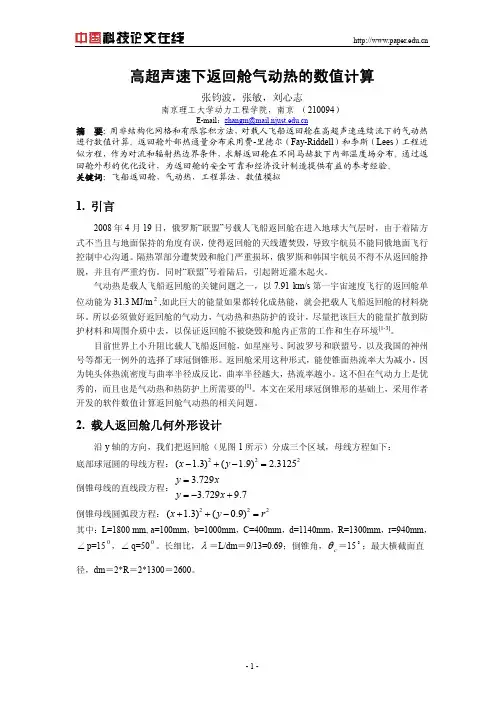
高超声速下返回舱气动热的数值计算张钧波,张敏,刘心志南京理工大学动力工程学院,南京 (210094)E-mail :zhangm@摘 要:用非结构化网格和有限容积方法,对载人飞船返回舱在高超声速连续流下的气动热进行数值计算。
返回舱外部热通量分布采用费-里德尔(Fay-Riddell )和李斯(Lees )工程近似方程,作为对流和辐射热边界条件,求解返回舱在不同马赫数下内部温度场分布。
通过返回舱外形的优化设计,为返回舱的安全可靠和经济设计制造提供有益的参考经验。
关键词:飞船返回舱,气动热,工程算法,数值模拟1. 引言2008年4月19日,俄罗斯“联盟”号载人飞船返回舱在进入地球大气层时,由于着陆方式不当且与地面保持的角度有误,使得返回舱的天线遭焚毁,导致宇航员不能同俄地面飞行控制中心沟通。
隔热罩部分遭焚毁和舱门严重损坏,俄罗斯和韩国宇航员不得不从返回舱挣脱,并且有严重灼伤。
同时“联盟”号着陆后,引起附近灌木起火。
气动热是载人飞船返回舱的关键问题之一,以7.91 km/s 第一宇宙速度飞行的返回舱单位动能为31.3 MJ/m 2,如此巨大的能量如果都转化成热能,就会把载人飞船返回舱的材料烧坏。
所以必须做好返回舱的气动力,气动热和热防护的设计,尽量把该巨大的能量扩散到防护材料和周围介质中去,以保证返回舱不被烧毁和舱内正常的工作和生存环境[1-3]。
目前世界上小升阻比载人飞船返回舱,如星座号、阿波罗号和联盟号,以及我国的神州号等都无一例外的选择了球冠倒锥形。
返回舱采用这种形式,能使锥面热流率大为减小。
因为钝头体热流密度与曲率半径成反比,曲率半径越大,热流率越小。
这不但在气动力上是优秀的,而且也是气动热和热防护上所需要的[1]。
本文在采用球冠倒锥形的基础上,采用作者开发的软件数值计算返回舱气动热的相关问题。
2. 载人返回舱几何外形设计沿y 轴的方向,我们把返回舱(见图1所示)分成三个区域,母线方程如下:底部球冠圆的母线方程:222( 1.3)( 1.9) 2.3125x y −+−=倒锥母线的直线段方程: 3.7293.7299.7y x y x ==−+ 倒锥母线圆弧段方程:222( 1.3)(0.9)x y r ++−=其中:L=1800 mm, a=100mm ,b=1000mm ,C=400mm ,d=1140mm ,R=1300mm ,r=940mm ,∠p=150,∠q=500。
贯流风机的数值模拟
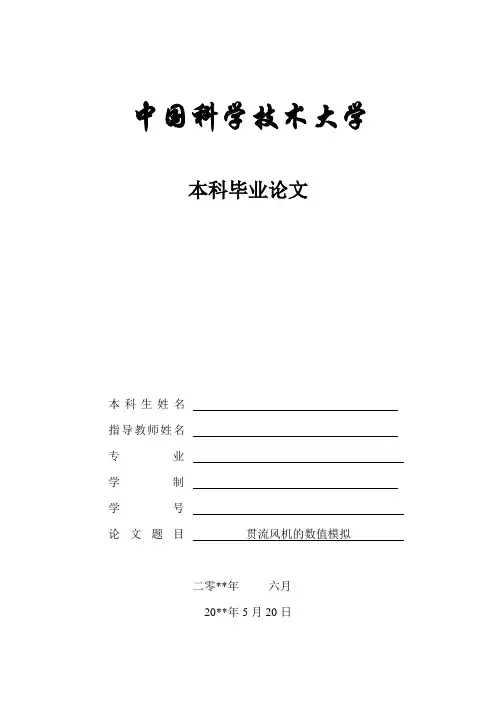
参考文献 ……………………………………………………………… 30
致谢
§1.1问题背景
贯流风机是一类特殊的通风机械,与离心式风机、轴流式风机相比较,贯流
风机具有结构简单、体积小、产生的气流平稳、动压系数较高而作用距离较长及噪声低等特点,近来被广泛应用于家用电器和空调设备等低压通风换气的场合,特别是在分体式空调的室内机中。然而由于贯流风机的特殊结构,加上其流动的非对称性与复杂性,使得对其性能的影响因素不甚明了,至今没有公认的设计理论。目前,国内的很多空调厂家都直接引进国外成熟的技术,进行COPY,独立开发的新产品很少,即使凭经验采用实验手段进行开发尝试,也会因为模具成本过高、开发周期过长而造成了巨大的浪费,显然不能满足国内空调市场对其性能提出的要求,更阻碍了国内空调厂家参与国际竞争。因此,对贯流风机的流场从理论上进行分析,搞清其性能的影响因素已成为迫切需要。
In this thesis, we want to supply a new method for the design of Cross-Flow fan, using the numerical simulation.
Keyword:Cross-Flow fan, numerical simulation, unstructured grid, pressure field, velocity field.
航空反潜作战效果综合评估
航空反潜作战效果综合评估陈遵银,杨建新,葛银茂,刘兰允(海军航空工程学院青岛分院,山东青岛266041) 收稿日期:2005205216 作者简介:陈遵银(1965-),男,江苏溧水人,副教授,主要从事航空反潜作战研究和教学工作。
摘 要:将模糊评判理论应用于航空反潜作战效果评估,通过给定的反潜作战剖面以及军事分析目标树,建立模糊综合评判模型,分析目标树各层因素之间的权重关系,运用模型进行计算,最终得到评估结果,为作战效果量化分析作一些基础研究。
关键词:航空反潜;作战效果;模糊综合评判;权重系数中图分类号:O22 文献标识码:A 文章编号:16712654X (2005)0320009203引言随着高技术在军事领域的广泛应用,武器装备、作战方法、人员素质发生根本性的变革。
为适应未来反潜作战的客观需要,除了发展装备技术以外,反潜训练还应在方法、内容、人员与装备结合等诸多方面研究,探索立足现有装备,寻求人员、环境和武器使用三者之间最佳组合训练方法,做好作战效果的评估就是重要内容之一。
目前,有关武器效能分析理论已经较为成熟,相关的文献也比较多,但效能分析大多是从固有效能和使用效能的角度出发来研究,许多因素被理想化,甚至被忽略掉。
本文从航空反潜作战的剖面出发,考虑到战术背景、作战环境、武器使用、人员素质等诸因素,在这些因素中有些可以确定,有些属于不确定性因素,采用模糊综合评判的方法去考核作战效果比较贴切,为航空反潜作战效果的量化评估奠定基础。
1 航空反潜作战剖面航空反潜作战通常是接到攻潜命令,应召飞抵作战海域,采用探潜器材或其它反潜兵力的引导对潜进行定位、跟踪、攻击。
其作战剖面如图1所示。
从作战剖面可以看出,航空反潜作战是一个非常复杂的战斗行动。
它涉及的因素多,如各类保障人员、战术人员、作战环境、潜艇定位精度、使用的武器性能等等。
这些因素均不同程度地影响到作战效果,在评价航空反潜训练效果时,应科学地确定影响程度的系数,但考虑到各因素之间的内在关系和不确定性,评估模型的建立应基于以下原则进行。
天津大学流体力学考研复习辅导资料及导师分数线信息
天津大学流体力学考研复习辅导资料及导师分数线信息天津大学流体力学考研科目包括政治、外语、数学以及理论力学、材料力学、自动控制理论、结构力学、高等代数,研究方向主要包括湍流与流动稳定性理论、湍流模式理论两个方向。
考生可根据自己的兴趣选择具体的研究方向。
专业代码、名称及研究方向考试科目备注080103★流体力学湍流与流动稳定性理论、湍流模式理论①思想政治理论②英语一③数学一④理论力学①思想政治理论②英语一③数学一④材料力学①思想政治理论②英语一③数学一④自动控制理论①思想政治理论②英语一③数学一④结构力学①思想政治理论②英语一③数学一④高等代数天津大学流体力学近两年考研录取情况院(系、所)专业报考人数录取人数机械工程学院(2012年)流体力学21 17机械工程学院(2013年)流体力学26 18天津大学流体力学2012年的报考人数为21人,录取人数17人,2013年的报考人数为26人录取人数18人。
由真题可以发现,现在考点涉及的广度和深度不断扩宽和加深。
由天津考研网签约的天津大学在读本硕博团队搜集整理了天津大学机械工程学院流体力学考研全套复习资料,帮助考生梳理知识点并构建知识框架。
真题解析部分将真题按照知识点划分,条理清晰的呈现在同学们眼前。
然后根据各个考点的近几年真题解析,让同学对热点、难点了然于胸。
只有做到了对真题规律和趋势的把握,8—10月底的提高复习才能有的放矢、事半功倍!天津大学流体力学考研导师信息刘正先教授纵向课题经费课题名称亚、跨声速下结构/气动参数与离心叶轮顶隙涡流耦合机理的研究2008-06-01--2010-07-01 负责人:刘正先科技计划:国家自然科学基金项目拨款单位:国家自然科学基金项目合同经费:80课题名称座舱空气非定常流动特征及数值模拟策略2 2012-01-01--2016-12-30 负责人:刘正先科技计划: 国家科技部拨款单位: 国家科技部合同经费:100 课题名称座舱空气非定常流动特征及数值模拟策略 2012-01-01--2016-12-30 负责人:刘正先科技计划: 国家科技部拨款单位: 国家科技部合同经费:98 课题名称技术应用 2010-01-01--2011-12-01 负责人:王树新科技计划:总装备部拨款单位:总装备部合同经费:100课题名称应用技术 2009-01-01--2011-12-01 负责人:崔玉红科技计划:航天集团拨款单位:航天集团合同经费:308横向课题经费课题名称高层大楼地下通风系统设计与调试 2014-08-30--2015-08-30 负责人:刘正先科技计划: 拨款单位:天津缆源建筑工程有限公司合同经费:16课题名称陕鼓1200KV闭式实验装置 2007-05-01--2012-12-30 负责人:刘正先科技计划: 拨款单位:陕西鼓风机动力集团公司合同经费:52课题名称环形风洞装置性能参数测试与改进 2012-05-01--2014-08-01 负责人:刘正先科技计划: 拨款单位:天津开发电力公司合同经费:15.22课题名称变电站室内电气设备运行环境问题技术研究数值模拟2012-10-01--2013-06-30 负责人:刘正先科技计划: 拨款单位:天津市电力公司合同经费:6.5课题名称干气密封性能及可靠性提升 2010-11-01--2010-12-01 负责人:刘正先科技计划: 拨款单位:核工业理化工程研究院合同经费:32期刊、会议论文刘正先,平艳,Zangeneh M. On the nature of tip clearance flow in subsonic centrifugal SCIENCE CHINA Technological SciencenullLiu zhengxian, Wang musu, Zhou Yue Dynamic Coupling Correlation of Gas Film in Dry Gas Seal with Spiral Groove Chinese Journal of Mechanical Engineeringnull刘正先,戴继双,王学军,张楚华Application of Factor Difference Scheme to Solving Discrete Flow Equation Based on Unstructured Grid Transactions of Tianjin Universitynull 黄章峰,刘正先Numerical study of a positive displacement blower Proc. IMechE Part C: J. Mechanical Engineering Sciencenull刘正先,邢海澎,陈丽英基于叶片载荷分布的离心叶轮气动优化工程热物理学报null 刘正先,周越双向干气密封气膜运行特性的数值分析工程热物理学报null刘正先,陈丽英亚音速半开式离心叶轮叶顶间隙的流动特征航空动力学报null刘正先,吴仲义半开式离心叶轮变工况间隙流动特征工程热物理学报null郝维,刘正先方腔涡流运动对压力脉动噪声影响的数值分析哈尔滨工程大学学报null刘正先,鲁寅,陈丽英叶顶间隙对离心叶轮气动性能的影响规律工程热物理学报null 刘正先, 王桂林粘性耗散效应对小流量系数离心压缩机气动性能的影响工程热物理学报null刘正先, 徐环,赵学录逆流冷却罗茨鼓风机涡流与排气脉动的数值分析航空动力学报null刘正先,徐莲环Numerical Simulation of Discharge Flow with Fluctuation in Positive Discharge Blower Chinese Journal of Mechanical Engineeringnull省部级以上获奖刘正先,段纪成真实气体透平机在线评估系统天津市科技进步奖二等奖2014-11-25刘正先杜庆华力学与工程奖杜庆华力学与工程奖一等奖 2014-06-30张利民,刘正先基于在线分析的真实气体离心压缩机闭式循环试验技术研究机械工业科学技术奖三等奖 2013-09-26李康,刘正先,孟庆国等涡轮气体流量计设计参数研究及新产品开发天津市科学技术进步奖三等奖 2005-12-30知识产权刘正先,郝维,吴仲义,陈丽英离心通风机中国 201210026433刘正先,邢海澎,吴仲义化工气体压缩机热力性能计算软件V1.0 中国 1刘正先,王牧苏一种双向旋转的干气密封端面槽型吴雪松(英国)教授纵向课题经费课题名称亚、超音速射流中不稳定波和相干结构的噪音产生机理2015-01-01--2018-12-31 负责人:吴雪松科技计划:国家自然科学基金拨款单位:国家自然科学基金合同经费:86课题名称高湍流度条件下曲面边界层转捩:机理和预测 2011-01-01--2015-12-31 负责人:吴雪松科技计划:国家自然科学基金拨款单位:国家自然科学基金合同经费:58 期刊、会议论文黄章峰,吴雪松 On non-parallel-flow effects on boundary-layer instability: anon-perturbative approach based on local expansion. null董明,吴雪松 Entrainment of Short-wavelength Free-stream V ortical Disturbances into Boundary Layers null董明,吴雪松On continuous spectra of Orr-Sommerfeld/Squire equations and entrainment of free-stream vortical disturbances J. Fluid Mech.null吴雪松,田峰Spectral broadenig and flow randomization in free shear layers J. Fluid Mech.null吴雪松,赵迪飞,罗纪生Excitation of steady and unsteady Gortler vortices by free-stream vortical disturbances J. Fluid Mech.null吴雪松On generation of sound in wall-bounded shear flows: back action of sound and global acoustic coupling J. Fluid Mech.null罗纪生,吴雪松On the linear instability of a finite Stokes layer: instantaneous versus Floquet modes Physics of Fluidsnull吴雪松,Huerre P. Low-frequency sound radiated by a nonlinearly modulated wavepacket of helical instability modes on a circular jet J. Fluid Mech.null吴雪松,张靖Instability of a stratified boundary layer and its coupling with internal gravity waves: Part 1 J. Fluid Mech.null吴雪松,张靖Instability of a stratified boundary layer and its coupling with internal gravity waves. Part 2. J. Fluid Mech.null吴雪松The influence of small imperfection on the transition of planne Poiseuille flow Physics of Fluidsnull本文摘自《天津大学818结构力学考研红宝书—全程版》,更多考研资料可登陆网站下载!。
基于浸入边界法和编程的圆柱绕流的数值模拟
基于浸入边界法和编程的圆柱绕流的数值模拟作者:牛朝来源:《价值工程》2018年第07期摘要:浸入边界法是在非结构网格下对N-S方程进行求解。
本文使用浸入边界法和有限差分法,运用C++编程实现对静止圆柱绕流的模拟,在不同雷诺数下求解不可压缩N-S方程和验证投影浸入边界法的可靠性,并分析圆柱周围速度场、压力场和涡结构的分布情况。
同时,得到了最优的网格划分范围。
Abstract: In immersed boundary method (IBM), N-S equations are solved with unstructured grid. In this article, we used IBM and the finite difference method, used C++ codes to simulate the flow over a static cylinder, to solve incompressible N-S equation and verify the reliability of projection of IB for the different Reynolds number. The distribution of velocity field,pressure field and vortex structure around circular cylinder were calculated and analyzed. At the same time, the best division of Cartesian grid is obtained.关键词:浸入边界法;有限差分法;圆柱绕流Key words: immersed boundary method;finite difference method;flow around a circular cylinder中图分类号:O174.63 文献标识码:A 文章编号:1006-4311(2018)07-0155-030 引言随着科技的发展和时代的进步,越来越多的水工建设和科学研究都涉及到流固耦合作用研究。
非结构网格的并行生成及其计算
南京航空航天大学硕士学位论文摘要研究非结构网格的快速生成在流场计算中有着至关重要的意义。
本文的主要目的是研究和发展非结构网格的并行生成技术,以实现快速生成非结构网格,从而为流场数值计算节省大量时间。
进一步配合流场有效的并行计算算法,最终可实现高效、快捷地模拟复杂流场。
本文改进了R.Lohner的“波阵面”区域分裂算法,使得区域分裂后的子区域及其边界更有益于网格的并行生成:针对区域初分裂后的公共边界,本文提出边界优化策略,改善了边界的光滑性,有益于并行生成过程中网格的质量。
利用改进的区域分裂算法,对并行生成的初始网格重薪划分,实现了网格的并行光顺,其中“虚拟”边界节点的光顺需要子区域之间相互通讯。
完善了文献[1]、[13]中的子区域内生成网格时接受新点及新单元的条件,在界面网格生成过程中,本文提出只接受新单元而拒绝新点的策略,节省了机时。
并行生成的时间、效率、加速比表明以上网格并行生成方法是高效的、可行的,成功实现了网格的快速生成。
在以上菲结构网格并行生成工作的基础上,本文进一步利用Euler方程的有限体积分区并行计算方法,对无粘可压缩绕流流场,在PVM分布式并行环境下进行了数值模拟。
在Euler方程的分区并行计算过程中,本文采用了Jameson有限体积法和四步Runge—Kutta显示时间推进格式。
流场区域的划分采用改进的“波阵面”区域分裂算法,“虚拟”边界单元的物理量的计算由子区域之间相互通讯来完成,信息的发送方式采用“循环式”发送方式。
数值试验的结果以及并行计算的加速比、效率的统计,进一步验证了网格并行生成方法以及并行计算算法的有效性。
关键{司:区域分裂;非结构网格;网格并行生成;有限体积法;并行计算非结构网格的并行生成及计算Abstract111estudyonhowtoqmcEygenerateunstructuredgridsisofgreatsignificanceforthefluidflowcalculation.Inordertosavethetimeofunstructuredmeshgeneration,themainworkofthispaperistodevelopthetechniqueofparallelunstructuredgridgeneration.Withtheeffectiveparallelcomputationalgorithm.thesimulationofcomplexinviscidflowisfinallyachievedmoreefficientlyandquickly.Inthispaper,wefirstlyimprovetheR.Lohner’Swavefrontdomain—splittingalgorithmthatthesubgridsandtheirboundariesaremorefavorableforgridgeneration.AnewSOoptimizationstrategyofsubdomain’Sboundaryisthenpresentedinordertoimprovethesmoothnessofboundariesandthequalityofgrids.Aftersubdividingtheinitialmeshesbyusingtheabovedomain-splittingalgorithm,wesmooththegridbytheparallelmethod.Inthisphase,smoothing‘‘subjunctive’’boundarypointsneedsmutualcommunicationofsubdomains.Next,wealsoimprovetheconditionsinthepaper【1],[13]ofreceivingnewpointsandelementsinthecourseofgridgenerationinthesubdomainandpresentanewstrategyofreceivingnewelementsonlyandrefusingnewpointsduringthecourseofgridgenerationoftheinterface,whichcansparemuchtime.TheresultsobtainedonthePVMenvironmentdemonstratehigheffectivenessofthealgorithms.Basedontheabovealgorithmofparallelunstructured鲥dgeneration,aparallelcomputingmethodiSappliedtoa2-DEulersolverfortransonicandsupersonicflowonaPVMparallelenvironment.Jamesonfinitevolumeschemeandfour.stageRung—Kuttatime-steppingmethodareemployedintheprocessofthezonalparallelcomputationofEulerequations.The“wavefront”domaindecompositionmethoddevelopedaboveiSusedinthedivisionofflowfielddomain.Thequantityofphysicsvariablesonthe“subjunctive”boundaryelementsneedsmutualcommunicationofsubdomainsduringthesimulation.Theresultsofnumericalexperiments,thestatisticsofspeedupratioandparallelefficiencyallshowthesuccessofparallelunstructuredgridgenerationmethodandparallelcomputationalgorithm.KeyWords:Domain-splitting,UnstructuredGrid,ParallelGridGeneration,FiniteVolumeScheme,ParallelComputingMethodII堕室堕至堕丞查堂堡主堂垡丝苎——第一章绪论1.1问题的背景近二三十年来,计算流体力学(CFD)作为现代流体力学新兴的学科分支,发展极为迅速,也取得了很大成功,已经与理论分析、风洞试验和飞行试验一起成为流体力学研究和飞行器设计的重要手段。
- 1、下载文档前请自行甄别文档内容的完整性,平台不提供额外的编辑、内容补充、找答案等附加服务。
- 2、"仅部分预览"的文档,不可在线预览部分如存在完整性等问题,可反馈申请退款(可完整预览的文档不适用该条件!)。
- 3、如文档侵犯您的权益,请联系客服反馈,我们会尽快为您处理(人工客服工作时间:9:00-18:30)。
H. K. Cheng has been a professor in Aerospace Engineering at the University of Southern California for the last three decades and a Professor Emeritus since Fall 1993. He completed his BS degree in aeronautical engineering at the Chaio-Tung University, Shanghai, 1947, Ph.D. degree in aeronautics at the Cornell University, Ithaca, 1952, and subsequently worked at Bell Aircraft Corporation as a research aerodynamicist until 1956 when he joined Cornell Aeronautical Lab, Buffalo (predecessor of ARVIN-CALSPAN), and was a principal aerodynamicist of the laboratory after 1959. Dr. Cheng visited Stanford University as a lecturer in 1963-64. His research and teaching covers theories in subsonic, transonic, supersonic and hypersonic flows, rarefied gas dynamics, rotating and stratified fluid flows, as well as unsteady aero-/hydro-dynamics applied to animal flying and swimming. He is a Fellow in AIAA and APS, a member of the SIAM, Phi Tau Phi, and an elected member of the U.S. National Academy of Engineering.
George Emanuel received a B.S. degree in mathematics from the University of California, Los Angeles, an M.S. degree in mechanical enginnering from the University of Southern California, and his Ph.D. in 1962 from Stanford University in aeronautical sciences. Subsequently, he spent nine years at The Aerospace Corporation, four years with TRW, and four years at the Los Alamos National Laboratory. He was a member of the technical staff at Aerospace and TRW, where his research and administrative duties primarily involved CW and pulsed, high energy chemical lasers. He published the first computer simulation of this laser. At LANL, he was staff to the applied photochemistry division with responsiblity for the physics, system, and econamics modeling of a new uranium enrichment process. Since 1980, he has been a professor of aerspace and mechanical engineering at the University of Oklahoma. He is the author of Gasdynamics: Theory and Applications and Advanced Classical Thermodynamics, both published by the AIAA education series, and, in 1994, Analytical Fluid Dynamics, published by the CRC Press. This is his 22nd article to appear in this journal; he is an Associate Fellow of AIAA. Received March 15,1994; revision received July 11,1994; accepted for publication July 13,1994. Copyright© 1994 by the American Institute of Aeronautics and Astronautics, Inc. All rights reserved.
Introduction
O
NGOING as well as new hypersonic flow programs continue to challenge the aerospace engineer. These programs are often of consuming difficulty, involving the synthesis of chemical kinetics, quantum mechanics, and radiation physics with fluid dynamics. To further complicate matters, the flowfield is often rarefied; thus the Knudsen number requires independent consideration along with the Mach and Reynolds numbers. Although these parameters are related, different regions of the flow, such as the interior of a bow shock, depend differently on them as compared with other regions. Because of its complexity, recent research has focused on the modeling of more realistic, complex hypersonic flows with the intensive use of computational fluid dynamics (CFD). Of necessity, the large codes used in this effort must resort to various empiricisms and approximations. Our objective in this Survey is to discuss some of these empiricisms and approximations within the context of hypersonic nonequilibrium flow. The issues and advances examined are primarily chosen for their relevance to theoretical gasdynamics; however, this Review makes no claim to being comprehensive. The books by Anderson1 and Park2 provide background material for the discussion of current issues, including lessons learned from the design and operation of the Space Shuttle. Our presentation is partly based on a previous report,3 some of which was published elsewhere.4 An alternative discussion of some of the same material can be found in an article by Tirsky5 whose discussion is especially valuable for emphasizing hypersonic research by Russian workers, with greater emphasis given to engineering heat transfer predictions. Some of this work is not as well known in the western community as it should be. The importance of finite rate chemistry and the problem of fuel-air mixing to hyper-
and G. Emanuel
University of Oklahoma, Norman, Oklahoma 73019 sonic airbreathing propulsion cannot be overemphasized.6 These topics, however, are omitted from our discussion in as much as they fall under combustion gasdynamics and ought to be examined in this context.7'8 The treatise on hydrogen combustion presented in Ref. 8 should be of interest to scramjet propulsion researchers. A broad perspective on hypersonic airbreathing vehicle design may be found in a survey (to be three volumes) edited by Bertin et al.9 In the next section, nonequilibrium aerothermodynamics is discussed. Much of this section is concerned with energy exchange that involves the vibrational modes of diatomic molecules. The subsequent section reviews the modeling of rarefied hypersonic flows and their continuum extension. There is no shortage of approaches that are available, as well as open issues. These approaches encompass the direct simulation Monte Carlo (DSMC) method, NavierStokes (NS) equations, Burnett, or augmented Burnett equations, and the 13-moment equations. The review concludes with a few brief remarks. Nonequilibrium Aerothermodynamics Current research developments in high-temperature flow physics still do not possess a methodology base with unquestioned certainty. A rational way to derive an equation set for a nonequilibrium flow is to write the time rate of population change of atoms and molecules, with a specific energy state /, as the difference between the sum of rates of all collisional and radiative transitions that populate a given state and the sum of rates that depopulate this state. Such a system is commonly referred to as the master equations; they furnish the source terms in the conservation equations for the species population of state /, Af/. The transition/emission rate for each collisional/radiative process is determined with the use of quantum me-
